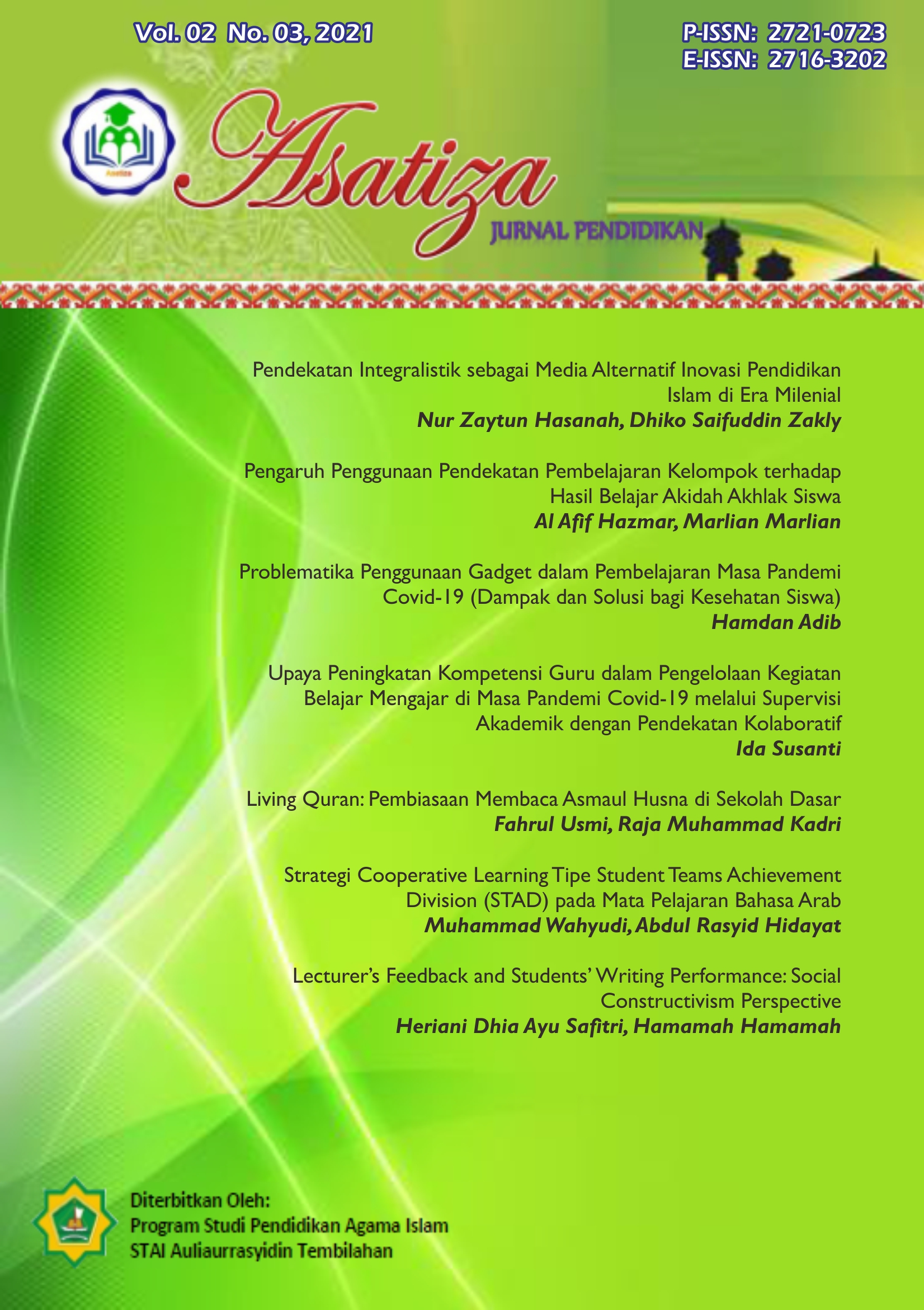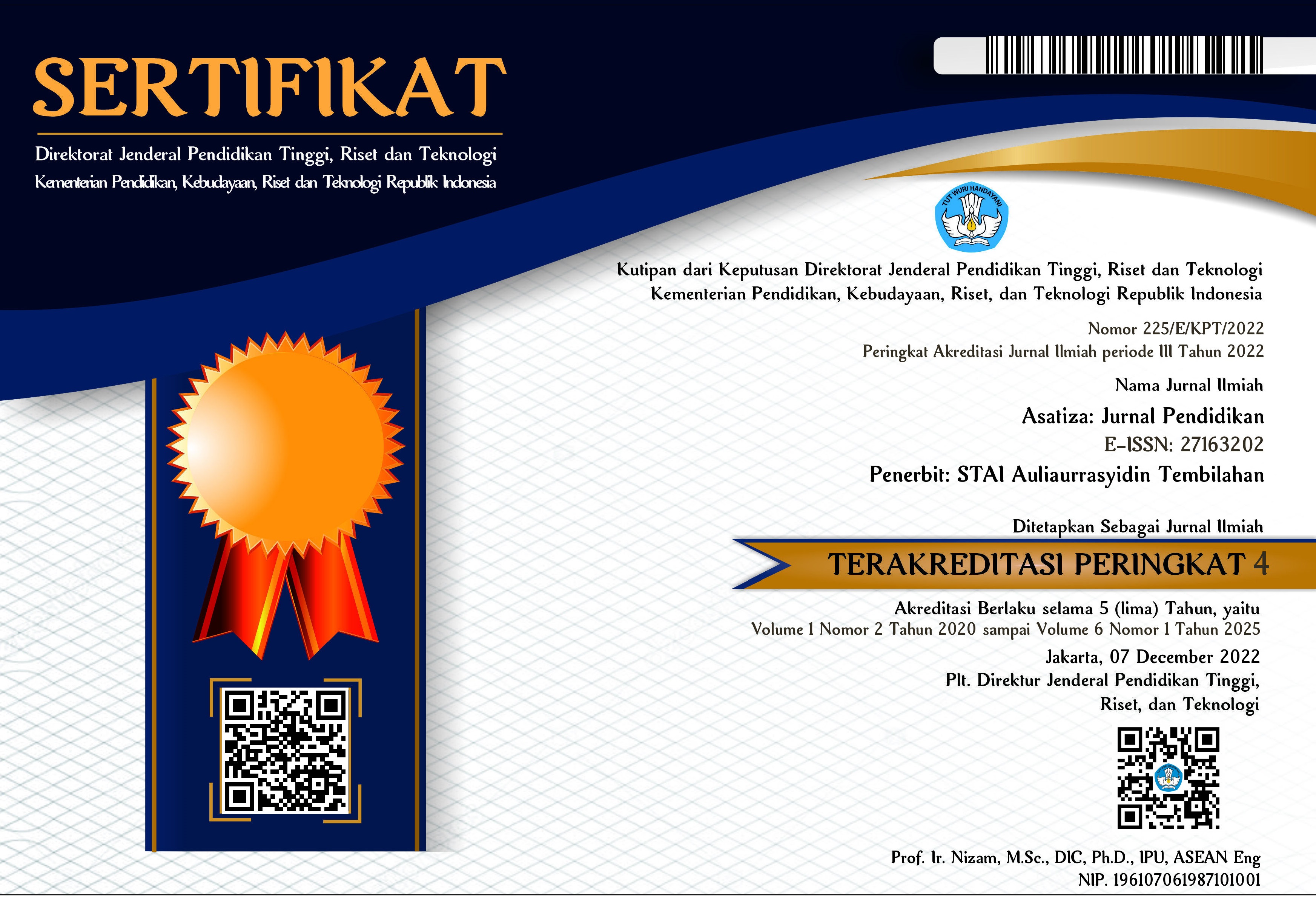Problematika Penggunaan Gadget dalam Pembelajaran Masa Pandemi Covid-19 (Dampak dan Solusi bagi Kesehatan Siswa)
DOI:
https://doi.org/10.46963/asatiza.v2i3.391Keywords:
Gadget, Covid-19, Learning, Student’s HealthAbstract
The purpose of this study was to determine the effect of learning innovation during the Covid-19 pandemic and its relation to students' physical and mental health. The method used was a qualitative method using library research. The study showed that during the Covid-19 Pandemic, the teachers and students conducted their teaching and learning using media such as laptops, smartphones, or tablets connected through the network by providers or WiFi. Students' physical health was distracted due to the duration of using those media was too long. At the same time, insufficient supervision by parents also affected their psychological health since all information spread very quickly without any qualified filter. However, teachers also experienced the same cases as students' have. This study suggests that parents should take action not only to monitor the duration of their children's learning but also the content they access.
Downloads
References
Albert Efendi Pohan, S. P. M. P. (2020). Konsep Pembelajaran Daring Berbasis Pendekatan Ilmiah. Penerbit CV. Sarnu Untung.
Anugrahana, A. (2020). Hambatan, solusi dan harapan: Pembelajaran daring selama masa pandemi covid-19 oleh guru Sekolah Dasar. Scholaria: Jurnal Pendidikan Dan Kebudayaan, 10(3), 282-289. https://doi.org/10.24246/j.js.2020.v10.i3.p282-289
Azka, F., Firdaus, D.F., Kurniadewi, E. (2018). Kecemasan sosial dan ketergantungan media sosial pada mahasiswa. Psympathic: Jurnal Ilmiah Psikologi, 5(2), 201-210. https://doi.org/10.15575/psy.v5i2.3315
Dewi, W. A. F. (2020). Dampak Covid-19 terhadap implementasi pembelajaran daring di Sekolah Dasar. Edukatif: Jurnal Ilmu Pendidikan, 2(1), 55–61.
Esther Setiawati, M. P., & Kids, H. H. (2016). Ayah Ibu Baik. Happy Holy Kids.
Hanum, N. S. (2013). Keefetifan e-learning sebagai media pembelajaran (studi evaluasi model pembelajaran e-learning SMK Telkom Sandhy Putra Purwokerto). Jurnal Pendidikan Vokasi, 3(1), 90-102. https://doi.org/10.21831/jpv.v3i1.1584
Iswidharmanjaya, D. (2014). Bila Si Kecil Bermain Gadget: Panduan bagi orang tua untuk memahami Factor-faktor Penyebab Anak Kecanduan Gadget, 1. Bisakimia.
Nazir, M. (2003). Metode penelitian. Ghalia Indonesia.
Noveandini, R., & Wulandari, M. S. (2010). Pemanfaatan media pembelajaran secara online (e-learning) bagi wanita karir dalam upaya meningkatkan efektivitas dan fleksibilitas Pemantauan Kegiatan Belajar Anak Siswa/i Sekolah Dasar. Seminar Nasional Aplikasi Teknologi Informasi (SNATI).
Nurmala, I. (2020). Mewujudkan Remaja Sehat Fisik, Mental dan Sosial: (Model Intervensi Health Educator for Youth). Airlangga University Press.
Pujiasih, E. (2020). Building a golden generation by applying various online learning in the pandemic of covid-19. Ideguru: Jurnal Karya Ilmiah Guru, 5(1), 42-48. https://doi.org/10.51169/ideguru.v5i1.136
Salsabila, U. H., Sofia, M, N., Seviarica, H. P., & Hikmah, M. N. (2020). Urgensi penggunaan media audiovisual dalam meningkatkan motivasi pembelajaran daring di sekolah dasar. INSANIA: Jurnal Pemikiran Alternatif Kependidikan, 25(2), 284-304. https://doi.org/https://doi.org/10.24090/insania.v25i2.4221
Subagijo, A. (2020). Diet dan Detoks Gadget. Noura Books.
Sugianto, V. J., Prayanto, W. H., & Yudani, H. D. (2015). Perancangan board game mengenai bahaya radiasi gadget terhadap anak. Jurnal DKV Adiwarna, 1(6), 1-15.
Sunarsa, S. (2020). Penelusuran Kualitas dan Kuantitas Sanad Qira’at Sab’: Kajian Takhrij Sanad Qira’at Sab’. Penerbit Mangku Bumi.
Tjandra, D. S. (2020). Impelementasi pembelajaran pendidikan agama Kristen di abad 21. SIKIP: Jurnal Pendidikan Agama Kristen, 1(1), 1-10. https://doi.org/10.52220/sikip.v1i1.33
Warkintin, W., & Mulyadi, Y. (2019). Pengembangan bahan ajar berbasis CD interaktif power point untuk meningkatkan hasil belajar siswa. Scholaria: Jurnal Pendidikan Dan Kebudayaan, 9(1), 82-92. https://doi.org/10.24246/j.js.2019.v9.i1.p82-92
Waryanto, N. H. (2006). Online learning sebagai salah satu inovasi pembelajaran. Pythagoras, 2(1), 10–23.
Zed, M. (2014). Metode Penelitian Kepustakaan. Yayasan Pustaka Obor Indonesia.
Zhafira, N. H., Ertika, Y., & Chairiyaton, C. (2020). Persepsi mahasiswa terhadap perkuliahan daring sebagai sarana pembelajaran. Jurnal Bisnis dan Kajian Strategi Manajemen, 4(1), 37-45. https://doi.org/10.35308/jbkan.v4i1.1981
Downloads
Published
Issue
Section
License
Authors who publish with this journal agree to the following terms:
1. Copyright on any article is retained by the author(s).
2. The author grants the journal, right of first publication with the work simultaneously licensed under a Creative Commons Attribution shareAlike 4.0 International License that allows others to share the work with an acknowledgment of the work’s authorship and initial publication in this journal.
3. Authors are able to enter into separate, additional contractual arrangements for the non-exclusive distribution of the journal’s published version of the work (e.g., post it to an institutional repository or publish it in a book), with an acknowledgment of its initial publication in this journal.
4. Authors are permitted and encouraged to post their work online (e.g., in institutional repositories or on their website) prior to and during the submission process, as it can lead to productive exchanges, as well as earlier and greater citation of published work.
5. The article and any associated published material is distributed under the Creative Commons Attribution-ShareAlike 4.0 International License











2.png)



